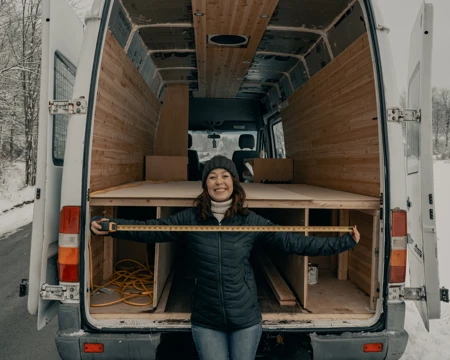According to Knight Frank, 8/10 people in the UK say that the energy efficiency of their next home purchase is more important to them than ever1. Some of this comes from concerns over the cost of energy, while others say they are more conscious of climate change because of high-profile events.
No matter the reason, it’s important to understand the financial implications of making improvements to your home. What is the actual cost of making your home energy efficient?
What’s involved in making your home energy efficient?
One of the first things you need to look at when making your home more energy efficient is the roof, your walls and your doors. You’ll need to ensure that these are properly insulated, with the most cost effective way to approach the problem being the ‘fabric first’ method.
You may also need to look at upgrading or improving the following home features:
- Heating systems
- Window glazing
- Lighting solutions
It can certainly feel overwhelming trying to understand what needs to happen in your home to make it more efficient, but you should have a handy guide already available.
Using your EPC as a guide
Your EPC, or Energy Performance Certificate, is useful for more than just telling you how energy efficient your home is. It’s also a very helpful document that tells you what you can do to improve it.
Of course, numbers on a piece of paper mean nothing unless you can take steps to change them, which is why all EPC reports must come with a recommendations section. These will be listed in order of importance and will also come with an indicative cost for each improvement.
These figures will be based on averages (as will the numbers below), but it’s still an excellent tool for planning and budgeting your energy efficiency improvements.

The cost of making your home more energy efficient
It’s difficult to place an exact figure on the cost of making your home more energy efficient, as everyone’s homes and needs are different. There will also be some variation based on the area you’re in, so it’s important to factor this in when you’re doing your calculations.
The below figures are based on information gathered from various trade sites and are as up-to-date as possible, although with the changes in inflation and interest, there may be differences in what you’re quoted.
Wall insulation
Wall insulation may include both interior and exterior, or just one of the two, and the cost will vary depending on what you need and the size of your home.
The average costs for external wall insulation are:
- Detached homes - £17,500
- Semi-detached - £9,000
- Mid-terrace - £7,000
According to Checkatrade2, the average cost for solid wall insulation is around £5,000-£10,400.
Floor insulation
Like most things home associated, floor insulation comes with varying costs, depending not only on the size of your home but the type of flooring you already have installed.
That being said, the average cost is around £8003, though that could go down to around £500 based on the materials you choose.
Eco-friendly options include:
- Natural fibres like wood, hemp, and straw
- Sheep's wool
- Recycled materials
- Fibreglass
- Eco-friendly spray foam
Roof and loft insulation
Roof and loft insulation could set you back anywhere from £9m2 to £600 for the whole loft4, depending on the level of insulation you need. If you’re looking for a quick and easy win, soft insulation is going to be your best bet, as it’s only a loose fill fabric. However, if you want to see a notable difference, then you’ll likely need to look at quilt insulation, which is on the upper end of cost (although that includes labour).
Improve windows and doors
Replacing or upgrading your doors and windows has a few benefits - namely, it means your home is warmer and will have fewer cold spots. They also help to keep your home quieter, as they insulate against external noise, while energy efficient glazing helps reduce the build-up of condensation on the inside of your windows.
According to the Energy Saving Trust, the average cost for a set of A-rated windows is around £7,5005 for a semi-detached house. This could save you up to £195 and reduce your carbon footprint by about 330kg each year.
Replacing your boiler
When you’re looking at a new boiler, you can expect to pay anywhere from £600 to £2,5006, depending on the heating requirements of your home and the specific type of boiler you need. With eco-friendly boilers, remember to look out for A rated products or higher.
A new combi boiler, which heats both your home and provides hot water, is far more energy efficient than other boiler types. They are a bit more expensive, and could cost anywhere from £1,500 to £3,500.
Draught proofing
Draught proofing is definitely one of the more affordable options for improving the energy efficiency of your home. As a quick win, it’s worth having it done, as it means you will probably be able to turn your thermostat down a little more, saving you extra money over the cooler seasons.
Professional draught proofing could cost around £2257 for the entire house. It is something you can DIY and will be cheaper that way, but some homes, especially ones with single glazed windows, will be more challenging to draught-proof.
Energy efficient lighting
One of the primary reasons people choose to replace their bulbs with LED options is to save money, but that’s because they’re inherently more energy efficient. They last longer and they’re cheaper to run, so it’s a win-win all around.
Costs will vary, but you can typically find affordable bulbs in packs of varying sizes. When you’re buying them, make sure you’re getting the right fittings and wattage for your light fixtures. To work out a cost, simply take the cost of a bulb and multiply it by the number of lights you want to change in your home.
Learn more in our Green Hub
Our Green Hub is packed with articles, ideas, and useful information about making your home energy efficient. Not only that, but there's plenty of information about reducing your carbon footprint, eco-proofing your home, and living a more sustainable life.
Check it out below!
Grants and schemes available
While draught proofing and LED bulbs may be affordable options for many, the rest of the cost to make a home more energy efficient can be a burden. The Green Homes Grant was an example of how the government aimed to help homeowners retrofit their homes, but that unfortunately closed in 2021.
Other examples of green grants and schemes available to the public include:
- Help to Heat - delivered through installers, local authorities and energy companies
- The Boiler Upgrade Scheme - running till 2025
- The Home Upgrade Grant- available to low-income households living in the worst performing homes
- The Energy Company Obligation - a way for energy suppliers to help households reduce the costs of their heating with energy-saving measures
Hopefully, there will be more grants and schemes available as public interest in green living increases. There are calls out for the government to replace the Green Homes scheme8, so we may need to just watch this space.
Find further guidance
There are several ways you can invest in a more energy efficient property. The first is obviously buying a home that’s already geared for efficiency, but in most cases this isn’t strictly realistic.
One of the best things you can do is invest in the property you have and find ways to make your home more eco friendly and efficient. This may involve saving for a while to make the improvements, or remortgaging to release equity to carry out your renovations.
It’s worth speaking to an expert in the housing industry before you make any major decisions. Get in touch with one of our advisers today - they can help you make the right decisions for your home and circumstances.
Resources and references:
1Knight Frank, 2022
2Checkatrade, 2022
3My Job Quote, 2022
4Checkatrade, 2022
5Energy Savings Trust, 2022
6Heatable, 2022
7Energy Saving Trust, 2022
8H&V News, 2022
Important information
Your home may be repossessed if you do not keep up repayments on your mortgage.
There may be a fee for mortgage advice. The actual amount you pay will depend on your circumstances. The fee is up to 1% but a typical fee is 0.3% of the amount borrowed.

